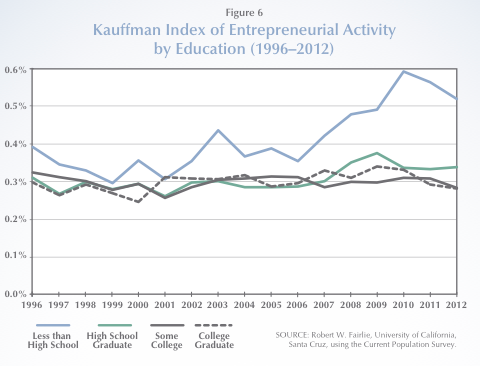
CATHERINE RAMPELL
Dollars to doughnuts.
The Affordable Care Act is expected to produce a sharp increase in entrepreneurship next year, according to a new report from the Robert Wood Johnson Foundation, the Urban Institute and Georgetown University’s Health Policy Institute. The number of self-employed people is expected to rise by 1.5 million — a relative increase of more than 11 percent — as a direct result of the health care overhaul.
One major barrier to entrepreneurship in the United States — beside the usual risks involved with starting a company — is that it has been difficult to get health insurance on the individual market. Those who do end up founding or joining a start-up are often able to do so because they have a spouse with employer-sponsored insurance, or because they are keeping a day job with a bigger company. (This was the case, for example, for most of the people involved with Leap2, a Kansas City start-up that I profiled last fall.)
Economists have looked at whether this insurance-related job lock is deterring self-employment and the formation of new businesses, and the data suggest it is. A Journal of Health Economics paper, for example, found that business ownership rates jumped sharply from just under age 65 to just over age 65, when people become newly eligible for Medicare. Using Current Population Survey data, the same paper also found that wage and salary workers are more likely to start businesses from one year to the next if they have a spouse with employer-based insurance.
A working paper from the Upjohn Institute looked at a change in the law in New Jersey that expanded access to individual health insurance. It found that the law seemed to increase self-employment, particularly among “unmarried, older, and observably less-healthy individuals.”
The report released Friday applies those findings to a model of what will happen in 2014, based on the Affordable Care Act’s provisions for “universal availability of non-group coverage, the financial assistance available for it, and other related market reforms.” The authors also adjusted their numbers depending on the access that residents of various states already have to individual health insurance. (Vermont, for example, already has a statute that allows the self-employed to obtain small group coverage.) Over all, they found, the ranks of the self-employed are likely to rise 11.5 percent, from about 13.1 million to 14.6 million. A table with their state-by-state estimates is below.
By the way, the paper does not mention this, but the same forces that will make it easier for workers to become self-employed may also make it easier for workers to retire early. I have heard anecdotally about people in their late 50s or early 60s who would like to retire but can’t do so because they’re basically uninsurable (for now) on the individual market; I wonder if we’ll notice a wave of retirements in this age group come 2014.
Article source: http://economix.blogs.nytimes.com/2013/05/31/affordable-care-act-could-be-good-for-entrepreneurship/?partner=rss&emc=rss

